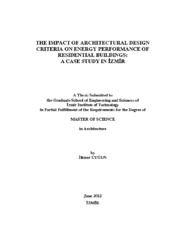Please use this identifier to cite or link to this item:
https://hdl.handle.net/11147/3486Full metadata record
| DC Field | Value | Language |
|---|---|---|
| dc.contributor.advisor | Kazanasmaz, Zehra Tuğçe | en |
| dc.contributor.author | Uygun, İlknur | - |
| dc.date.accessioned | 2014-07-22T13:51:39Z | - |
| dc.date.available | 2014-07-22T13:51:39Z | - |
| dc.date.issued | 2012 | en |
| dc.identifier.uri | http://hdl.handle.net/11147/3486 | - |
| dc.description | Thesis (Master)--İzmir Institute of Technology, Architecture, İzmir, 2012 | en |
| dc.description | Includes bibliographical references (leaves: 101-107) | en |
| dc.description | Text in English;Abstract: Turkish and English | en |
| dc.description | xi, 162 leaves | en |
| dc.description.abstract | The impact of architectural configuration and design norms on energy performance of buildings has been a critical issue. Even, it becomes noteworthy for residential buildings of good quality. New legislation in Turkey which was prepared to comply for the latest European Energy Performance of Buildings Directive 2010/31/EC requires information about the evaluation of energy performance of existing buildings. So, this study aimed to determine energy performance of residential buildings in Izmir, to analyze significant relationships between their performance and architectural configuration through statistical analyses (analysis of variance (ANOVA), regression, t-Test, scatter charts). Utilizing production drawings, certain area-based ratios and building dimensions were determined as architectural configuration indicators. Most prevailing architectural variables, such as, zoning status, external surface area and A/V ratios, and others, namely, orientation, floor counts in a building, aspect ratio, heating system were analyzed. Energy performance of case buildings were determined by using The Standard Assessment Method for Energy Performance of Dwellings (KEP-SDM) which referred to Turkish standard TS 825, and European standard EB ISO 13790. Majority of the investigated buildings were in Energy Class B and C, in CO2 Class G; however, their energy consumption values were two times higher than the ones in European countries. Findings present such a clue that interactions between variables and their total effect on the energy performance and CO2 emissions should be taken into consideration. They would also provide feedback information on the residential building stock in İzmir, selected as a representative city in Turkey. | en |
| dc.language.iso | en | en_US |
| dc.publisher | Izmir Institute of Technology | en_US |
| dc.rights | info:eu-repo/semantics/openAccess | en_US |
| dc.subject.lcsh | Architecture and energy conservation--Turkey | en |
| dc.subject.lcsh | Dwellings--Turkey--İzmir | en |
| dc.title | The impact of architectural design criteria on energy performance of residential buildings: A case study in Izmir | en_US |
| dc.type | Master Thesis | en_US |
| dc.institutionauthor | Uygun, İlknur | - |
| dc.department | Thesis (Master)--İzmir Institute of Technology, Architecture | en_US |
| dc.relation.publicationcategory | Tez | en_US |
| item.languageiso639-1 | en | - |
| item.fulltext | With Fulltext | - |
| item.openairecristype | http://purl.org/coar/resource_type/c_18cf | - |
| item.openairetype | Master Thesis | - |
| item.grantfulltext | open | - |
| item.cerifentitytype | Publications | - |
| Appears in Collections: | Master Degree / Yüksek Lisans Tezleri | |
Files in This Item:
| File | Description | Size | Format | |
|---|---|---|---|---|
| T001029.pdf | MasterThesis | 3.46 MB | Adobe PDF |  View/Open |
CORE Recommender
Page view(s)
122
checked on Jul 22, 2024
Download(s)
62
checked on Jul 22, 2024
Google ScholarTM
Check
Items in GCRIS Repository are protected by copyright, with all rights reserved, unless otherwise indicated.